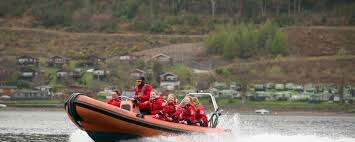Powerboating Safety Notice
5th September 2025

This year we have seen a rise in powerboating incidents being reported into our [HQ] Safety team. These have including boat collisions, capsizes, engine failures, and individuals falling overboard into open water.
Fortunately, there were no serious injuries on these occasions, but there easily could have been.
We have conducted – or are in the process of conducting – local learning reviews for each incident reported so far this year. We are also working closely with the Marine Accident Investigation Branch (MAIB).
It is timely for us to bring these incidents to your attention and request that you are making sure activities locally are being robustly risk assessed, boat and equipment checks are undertaken, and session plans are being created before activities.
Reminders of key safety measures.
We remind you that all powerboating activities in Scouts, including those supporting other water activities (e.g. sailing), must follow these mandatory checks:
To be completed by the Leader in Charge and Lead Volunteer/Activity Approver:
1. Risk Assessments:
An appropriate risk assessment is in place for the activity, this should be shared with all volunteers and young people involved in the activity. This must cover all elements and aspects of the activity you are planning, including the preparation before and pack down after the main session.
2. Boat and Equipment Checks:
In depth checks should be completed throughout the season to ensure safety while using these vessels. Guidance on boat checking can be downloaded, here, and an example check list can be found here. This includes maintenance schedules and reports for mechanical components (e.g. Outboard engines).
The maximum capacity of the vessel should be marked within the vessel and must be followed at all times. For older vessels, this needs to be reviewed as part of the in-depth boat checks.
3. Session Planning:
A session plan must be developed, including who will be helming a powerboat and for what purpose. This allows the experience, competency and permit information to be checked to ensure that powerboats are being helmed by volunteers/members with the correct and appropriate skills.
4. Laws and byelaws:
A check that all laws and local byelaws are being followed. Including any port/ harbour procedures. This should be shared with all people involved in the delivery of the activity.
5. Incident Reporting:
All powerboating incidents at sea - regardless of classification and severity – must be reported to the MAIB. The safety team is available to support you through this process. The report form can be downloaded here.
To be completed by the Leader in Charge on the day of activity and during the activity:
Boat and Equipment Checks:
Boat pre-use checks before each session to ensure safety while using these vessels. This also must be available to be reviewed by the appropriate lead volunteer if required.
The maximum capacity of the vessel must be followed at all times.
Two appropriate mechanisms for calling for help should be available and tested. Where this includes a VHF radio, a successful radio check must happen before leaving the mooring if operating at sea/ out of a harbour. This should be to the Coastguard on channel 16, or another appropriate local facility in your area such as National Coastwatch Institution, before starting the activity.
Appropriate clothing for the water temperature is considered. Water temperature of 15 degrees or below increases the risk of cold-water shock and cold-water incapacitation if a person was to enter the water.
A check that all Personal Protective Equipment is appropriate for the activity and is fitted correctly, well maintained and managed in accordance with the guidance set out here.
A check that the appropriate Safety Equipment is held on board to manage a situation where fading light may become a factor.
Risk Assessments:
A daily risk assessment should be completed by the Leader in Charge of the activity. This should include sea state/ water conditions, the weather and the wind speed. An example from the RYA can be found here.
Dynamic Risk Assessment must take place throughout the session, please remember to record all dynamic risk assessments and share with the relevant people. Always remember to go back and review the main risk assessment after the session to ensure these findings are recorded.
We hope these reminders are useful and constructive. Sometimes when we are involved in activities which we participate in on a regular basis, complacency can set in.
Permit holders, Assessors, and District Lead Volunteers share responsibility for ensuring powerboating is conducted safely, with focus on skill development and positive experience for young people.
These safety checks and procedures are essential. This has been demonstrated by the fact we have had incidents in open water this year which could have resulted in very serious injury in other circumstances.
Powerboating is a fun activity and as Scout leaders we lead by our example. Incidents which occur even where there are no young people involved reflect on Scouting.
Your support in respect of these asks is very much appreciated so these activities can continue. With your continued commitment to safety and respect for the water, we can ensure powerboating remains a valuable and enjoyable experience for all.

